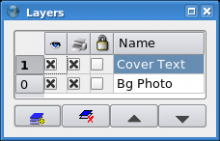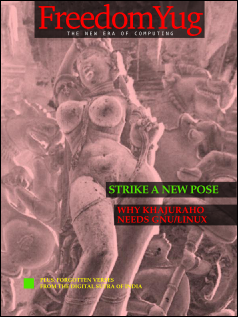Prise en main de Scribus:5
Prise en main de Scribus
| ||||||||
Chapître 5
|
- Ce que vous pouvez faire avec Scribus
- Scribus et ses frères
- Vide et réserves
- Page de couverture
- Travailler avec des calques
- Design Multiple Pages
- Create Final Page Layouts
- Design With Graphics And
Freedom - Set Fire With SVG Graphics
- Publishing Demands Freedom.PDF.
- Travel At The Speed Of Scribus
- Contributors
- GNU Free Documentation Licence
Travailler avec des calques sur une Page
Pourquoi utiliser des calques
Nous allns bientôt mettre en forme le texte du We are going to format the text for the magazine's masthead, the headline, and the subhead du magazine. Imaginez celui-ci soit produit dans plusieurs langues. Une façon de faire serait de recréer la mise en page pour chaque langue. l'autre façon consiste à mettre chaque langue sur un calque. Songez aux calques comme à des feuilles transparentes qui se superposent. Vosu pouvez afficher ou cacher des calques, par exemple : cacher le calque contenant le texte en anglais, et montrer celui cotnenant l'hindi.
Les calques apportent énormément pour la mise en page. Pour notre magazine, je garderai le fond et les bandes sur un calque, et placerai le texte sur un second. Allez dans Fenêtre>Calques. Dans la fenêtre qui apparaît, vous apercevez certainement un calque existant. Décochez l'icône représentant un oeil et tosu les éléments de ce calque vont disparaître, laissant une page vide.
Double-cliquer sur le nom de ce calque et écrivez 'Bg Photo'. Cliquez alors sur l'icone en bas à gauche pour ajouter un nouveau calque au-dessus du calque existant. Changez le nom de ce calque en 'CoverText'. Assurez-vous que ce calque soit en surbrillance de manière à ce que Scribus comprenne que c'est sur celui-ci que vosu souhaitez ajouter des élèments. Assurez-vosu aussi que l'oeil de ce calque est affiché de manière à bien percevoir le contenu à venir.
Ajouter du texte dans un cadre
Assurez-vous que le calque CoverText est activé dans la fenêtre Calques. Cliquez sur l'icône de cadre de texte ![]() dans la boîte à outils (clavier: T) et cliquez et glissez la souris par-dessus MastheadBand. Pour l'instant, faite un cadre aussi large que la page et approximativement deux fois la hauteur du MastheadBand. Cliquez sur l' icone de l'éditeur interne
dans la boîte à outils (clavier: T) et cliquez et glissez la souris par-dessus MastheadBand. Pour l'instant, faite un cadre aussi large que la page et approximativement deux fois la hauteur du MastheadBand. Cliquez sur l' icone de l'éditeur interne ![]() dans la boîte à outils (raccourcis: Ctrl+Y). Il est placé à côté du bouton d'édition de contenu
dans la boîte à outils (raccourcis: Ctrl+Y). Il est placé à côté du bouton d'édition de contenu ![]() . Une fenêtre apparaît, dans laquelle vous pouvez entrer le texte que vous souhaitez publier dans ce cadre. Pensez à l'éditeur interne comme à un bloc-note ou à un traitement de texte à utiliser pour chaque cadre. C'est la seconde fenêtre en terme d'importance dans Scribus, après les Propriétés que nous avons déjà vue. Écrivez le texte : “FreedomYug” dans Editeur interne. Cliquez sur Fichier > Enregister et quitter à l'intérieur de Editeur (Fichier > Mettre à jour et sortir dans la version 1.3.X). Cela place votre texte dans le cadre et ferme l'éditeur interne.
. Une fenêtre apparaît, dans laquelle vous pouvez entrer le texte que vous souhaitez publier dans ce cadre. Pensez à l'éditeur interne comme à un bloc-note ou à un traitement de texte à utiliser pour chaque cadre. C'est la seconde fenêtre en terme d'importance dans Scribus, après les Propriétés que nous avons déjà vue. Écrivez le texte : “FreedomYug” dans Editeur interne. Cliquez sur Fichier > Enregister et quitter à l'intérieur de Editeur (Fichier > Mettre à jour et sortir dans la version 1.3.X). Cela place votre texte dans le cadre et ferme l'éditeur interne.
Enjoliver le texte
'FreedomYug' sera plus agréable si l'espace entre les lettres est réduit, et si le texte s'inscrit parfaitement dans MastHeadBand. L'espace entre les lettres s'appelle 'approche'. Pour réduire l'approche, Cliquez droit sur le cadre d'image, et à partir du menu, choisissez 'Propriétés'. Dans Forme décochez 'utiliser la forme du cadre'. Et en haut de cette fenêtre, cliquez sur Texte.
Tracking
From the drop-down menu of Fonts in the Properties dialog box, choose 'Utopia Regular' or else Times Roman or any other font you fancy. Make the size: 84 points. Traditionally, a point is a unit of measure in the printing industry. 72.27 points make an inch. In digital print publishing, this is rounded-off to 72 points make an inch. Text size is usually measured in points. Select 'Red' from the drop-down menu next to the bucket icon, which stands for 'Fill Color' for our text. In the field labelled ![]() (Tracking in Scribus 1.2.*), enter -5 pts. Set the value of the
(Tracking in Scribus 1.2.*), enter -5 pts. Set the value of the ![]() field (Line Spacing in Scribus 1.2.*) to 72 pts. You will find the gaps between the text has squeezed, and the text has changed to the color red.
field (Line Spacing in Scribus 1.2.*) to 72 pts. You will find the gaps between the text has squeezed, and the text has changed to the color red.
Note that all of these font sizes, settings, and positioning values may vary depending on which exact font you choose. The important thing is to fit them in the space provided, with a look that is pleasing to you. In particular, you may find that the text frame height may need to be much larger than you expect. Look for a small rectangle with an X inside in right lower corner of the frame that tells you there is not enough space for the text
| Troubleshooting text that won't appear
If you are struggling to have your text appear:
|
More Text, More Frames
Use the same technique, make new text frames as follows:
| Content | Font (or similar) | Color |
|---|---|---|
| THE NEW ERA OF COMPUTING | Bitstream Vera Sans Mono Roman | White |
| STRIKE A NEW POSE | URW Palladio L Bold | LimeGreen2 |
| WHY KHAJURAHO NEEDS GNU/LINUX |
URW Palladio L Bold | Red |
| PLUS: FORGOTTEN VERSES FROM THE DIGITAL SUTRA OF INDIA |
URW Palladio L Bold | Yellow |
Adjust size, tracking and line spacing to fill the space as needed.
And While We're At It
Here is an excerpt from Working with text frames elsewhere on the Wiki. You should find this useful when adjusting sizes, positions, and other settings.
There are three ways to change the individual settings --
- editing with the keyboard
- clicking on the up or down arrows to the right of each value. The keyboard up and down arrows will accomplish the same thing.
- using the mousewheel on each setting -- usually hovering the cursor will be enough, if not, click on the value first
Also note that for 2 and 3, holding down Ctrl, Shift, or Ctrl+Shift will alter which decimal place is affected. In addition, when using the Properties window width and height are by default linked, but you need only click the chain icon to the right to unlink them. Refer to this article for more on keyboard shortcuts.


